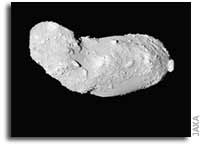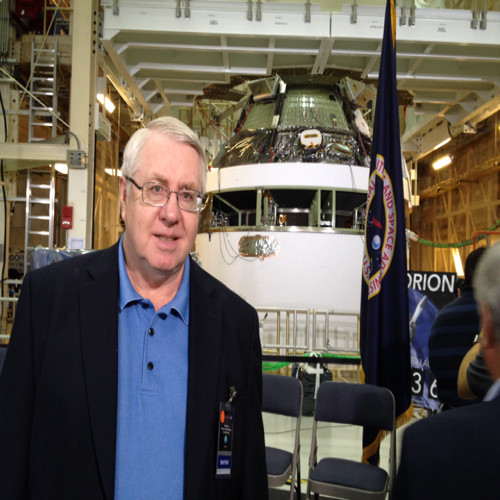Historic Japanese Asteroid Data Amaze Researchers

Reprinted with permission of Aviation Week & Space Technology
Japan’s Hayabusa spacecraft that landed twice on the asteroid Itokawa found it to be a “rubble pile” of 4.5-billon-year-old planetary debris that loosely coalesced only about 10 million years ago, rather than a much older intact body like previous asteroids visited.
This means researchers discovered–180 million mi. from Earth–a new baby of the solar system. It’s just one of many findings from the $100-million mission that will affect theories on the formation of planets and small bodies around the Sun and other stars.
In addition to being perhaps the youngest known object in the Solar System, the asteroid is likely a “contact binary–a joined pair of earlier separate objects–the first such conjoined twins ever viewed up close in deep space. The juncture between two objects is clearly visible as a smooth neck area between a rounded head and an elongated body. There are plenty of rocky boulders up to 150 ft. in diameter, but minimal evidence of significant craters and regolith that would show the object to be older.
The Hayabusa data are a reminder “to expect the unexpected” in planetary exploration, said mission managers at the 37th Lunar and Planetary Science Conference here in mid-March.
One new revelation is that during one landing, the spacecraft bounced twice, then remained on the surface an unexpectedly long 35 min. These bounces and long dwell time could have given asteroid material, disturbed in microgravity, enough time to inadvertently float into the spacecraft’s collection device, even though a sample blasting mechanism did not fire properly.
The Hayabusa observations will be a significant element in international planning for future missions to asteroids and comets. Japanese Aerospace Exploration Agency (JAXA) managers say the striking findings, and relative success of the mission, will cause them to elevate future asteroid missions for approval.
As an Earth-crossing asteroid, Itokawa has a reasonably high statistical chance of striking Earth in a million or more years from now, JAXA says. The agency says this means the Hayabusa data are important for risk assessments for other asteroids colliding with Earth possibly much sooner with potential catastrophic consequences for mankind.
Several independent researchers here said the data assure a lasting legacy for the mission, even if it fails to return samples of the asteroid, its primary goal.
The mission in deep space has been an ongoing drama for the last six months. Hayabusa landed on the asteroid twice in November in an attempt to collect samples. Spacecraft telemetry, however, indicates it’s doubtful the sampling system worked properly. But that’s yet to be determined, and samples may actually be on board.
Extreme surface closeups showed even the smooth-looking touchdown area was made up of marble- or pebble-size rocks solidly packed together. One researcher compared the Hayabusa surface closeup 180 million mi. away to a similar closeup picture of gravel pavement at the nearby Johnson Space Center–and to the amusement of everyone, the two pictures looked about identical.
A malfunction of the spacecraft’s chemical thruster system resulted in a loss of contact with the vehicle in December. But contact has now been restored and JAXA managers hope in 2007 to use the spacecraft’s ion engines to propel it back to Earth for retrieval of the sample capsule in 2010 near Woomera, Australia.
But the ion system has precious little attitude control authority, compared with the chemical thruster system that failed because of a leak. As a result, for the next several months, every heat-generating instrument and system on Hayabusa is being powered on to “bake out” any remaining chemical propellant that could vent in a propulsive manner, tumbling the spacecraft beyond the control authority of the ion engine system (AW&ST Mar. 13, p. 29).
But Hayabusa’s high-resolution imaging system and infrared and X-ray spectrometers have already provided landmark science data.
“Rubble pile asteroids are something we always figured would be out there, and suddenly, ‘voila,’ there was one in front of us,” says Andy Cheng, a member of the Hayabusa science team from Johns Hopkins University’s Applied Physics Laboratory (APL).
There are two main theories about how the two objects originated. One theory, supported by geologic and other data, is that the asteroid could have been formed by two rubble-pile asteroids that formed separately, but then collided, Japanese investigators say. Or its genesis could have been a variation on that theme, where what is now the asteroid was broken off a much larger single body in a collision. Under this hypothesis, the larger object could have been blasted by a collision that broke it into pieces, with the current Itokawa then formed out of the eventual second collision of two rubble-pile objects blasted from the parent body.
In either case, the science data indicate two bodies found each other in space and joined, to form a 2,000 X 400-ft.-wide object that has a rounded head at one end, an area of more fine-grained material at the neck and a more rugged boulder-strewn body.
It’s a major mystery how two objects each the size of skyscrapers could collide without blowing each other to smithereens. This is especially puzzling in a region of the Solar System where gravitational forces would normally involve collision speeds of 2 km./sec., says Donald Yeomans, a member of the Hayabusa science team from the NASA Jet Propulsion Laboratory.
“It is difficult to figure out how these two bodies could have collided and stuck together, but Mother Nature must have figured this out a long time ago,” he told the planetary conference. A third theory that received somewhat less discussion is that gravity forces from a planetary near-miss may have stretched the asteroid into two conjoined sections.
Rubble-pile asteroids have long been postulated as being formed when relatively unheated, unaltered 4.5-billion-year-old debris from the formation of the rocky planets pulled itself together into loosely formed bodies by extremely tiny gravity forces. Due to larger gravitational effects, these bodies formed between Mars and Jupiter–the asteroid belt with millions of pieces of Solar System debris. Spacecraft have imaged more homogeneous, intact asteroids, but never a rubble pile.
When the APL Near-Earth Asteroid Rendezvous (NEAR) spacecraft flew to the much larger asteroid Eros in 2000, researchers expected to find a rubble-pile asteroid; but they did not.
Eros is a much more solid body, with unusual cracks throughout, but a more homogeneously formed object with a relatively smooth surface. “That’s still surprising to many people,” says Cheng, who was also the NEAR science manager.
As Hayabusa approached, then flew in formation with Itokawa, the relatively smooth but grooved terrain found on Eros was nowhere to be seen. “Instead, we found almost a patchwork-quilt kind of appearance; you have rough, bouldery sections and then very smooth sections. It was instantly recognizable as a ‘different kind of beast,'” says Cheng.
“And then we realized, this is what a real rubble-pile asteroid looked like–something like nobody had guessed.”
The Lunar and Planetary Science Conference drew more than 1,500 managers and scientists from diverse exploration programs, including a team led by David S. McKay of the Johnson Space Center that presented new research indicating more evidence that ancient life on Mars could have been preserved in Martian meteorites (AW&ST Mar. 20, p. 28).








